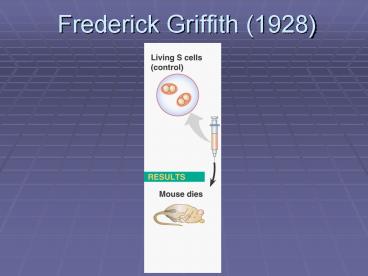Frederick Griffith (1928) - PowerPoint PPT Presentation
1 / 20
Title:
Frederick Griffith (1928)
Description:
Hershey & Chase (1952) 'Bacteria eaters'- Phage virus particles (image from the 1990s) ... Hershey & Chase (1952) DNA. Nucleic acids are made of four ... – PowerPoint PPT presentation
Number of Views:138
Avg rating:3.0/5.0
Title: Frederick Griffith (1928)
1
Frederick Griffith (1928)
2
Frederick Griffith (1928)
3
Frederick Griffith (1928)
4
Frederick Griffith (1928)
5
Avery, McCarty MacLeod (1944)
- Only DNA (not protein, lipid or carbohydrates)
TRANSFORM bacteria
6
Hershey Chase (1952)
- Bacteria eaters- Phage virus particles
- (image from the 1990s)
7
Hershey Chase (1952)
- Viruses are made of protein and nucleic acid
ONLY - Something in the virus enters the cell and
gets incorporated into the genetic material
(whatever that might be) of the bacteria - That something transforms bacteria to turn
them into virus production factories - Protein is full of a lot of the atom Sulfur
nucleic acids have very little - DNA is full of the atom phosphorus proteins
have very little
8
Hershey Chase (1952)
9
Hershey Chase (1952)
- Bacteria eaters- Phage virus particles
- (image from the 1990s)
DNA
10
Generally accepted
- Nucleic acids are made of four components
- Phosphate group
- Sugar (deoxyribose ribose)
- Nitrogenous bases
- Pyrimidines (1-ring)
- Purines (2-ring)
11
Erwin Chargaff (1947)
- All living cells have DNA (plus many that are
not living) - Between species there is wide variation in the
overall percentages of A, T, G C - However, in all species A T, C G
- E.g.- Human A- 30.3, T 30.3 , G 19.5, C
19.9 - Chargaffs Rules
- Also, a cell before meiosis has twice as much
DNA as a cell (sperm, egg) after
12
Franklin (1951- 52)
- X-ray diffraction crystallography
13
Franklin (1951- 52)
- Image 51
- Helix
- Repeating units
- unit cell of specific
- parameters
- Phosphates on
- the outside (bases
- inside) backbone
- C2 form
- Parallel width along length
14
Watson Crick (1952)
- Parallel width along length
- Backbone must be parallel
- Bases fill in the space between the rungs
- But how?
15
Watson Crick (1952)
- Many Ah-Hahs
- A bonds to T (2 bonds), C bonds to G (3 bonds)
and NOT vice versa - Consistent with whose previous research?
16
Watson Crick (1952)
Nucleotide
- Many Ah-Hahs
- C2 form?
- All the data fit
- with Franklins,
- Chargaffs, etc
- conclusions
17
Watson Crick (1952)
- All the data fit with Franklins, Chargaffs,
etc conclusions - And it looks good too!
18
Watson Crick (1952)
- Part I- the model (what it looks like)
- Part II- how it works (the secret of life)
- Complimentarity replication
- The Central Dogma information storage
19
Watson Crick (1952)
- The Central Dogma information storage
DNA
PROTEIN
RNA
Enzymes
Cell Structure
Nucleic Acids
Lipids
Carbohydrates
20
Watson Crick (1952)
- Complimentarity replication
- Their Model (paper 2)
- Semi-conservative replication































